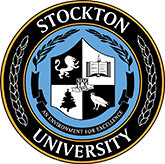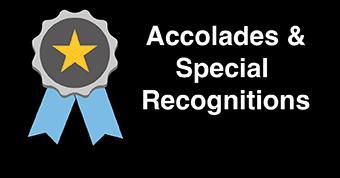Still Here, Still Creating
Still Here, Still Creating
By Mandee McCullough ‘04
"Indigenous people are more than just what you read about in your false and colonial history books or a concept of the past. In 2024, we are contemporary," Indigenous artist Denise "Bright Dove" Ashton-Dunkley shared to a packed Stockton University Art Gallery during an Artist Talk & Workshop this past September.
Ashton-Dunkley of the Nanticoke/Lenni-Lenape Tribal Nation was among 25 local and international artists featured in the two-floor exhibition, "Indigenous Approaches, Sustainable Futures," displayed last fall. She and fellow tribe member Tyrese "Bright Flower" Gould Jacinto and Jeremy Dennis of the Shinnecock Indian Nation led participants on a tour of the exhibition and talked about the inspiration behind their featured works.
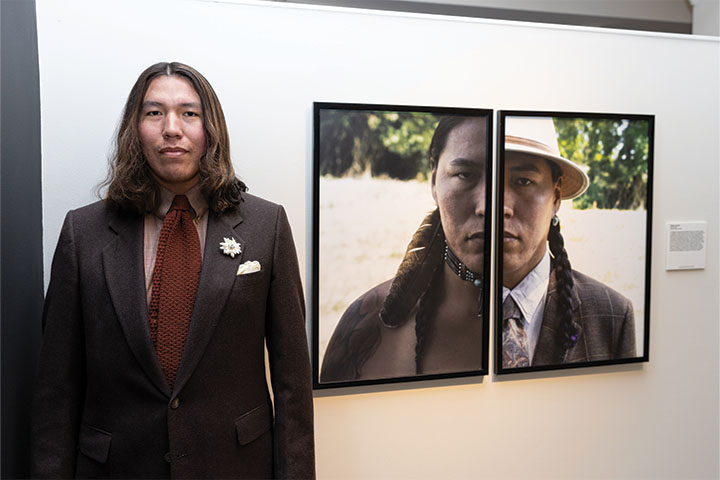
This exhibit, which not only featured art but also interactive workshops, began an autumn journey at Stockton of sharing insight into the rich beauty and perceptions of Indigenous cultures.
During the exhibit, Gould Jacinto introduced participants to the art and history of gourd painting. The workshop was an extension of the exhibited gourd art series "Seeds of My Ancestors." According to Gould Jacinto, the series explores the relationship between "land, identity and sustainability."
Mariana Smith, associate professor of Art and co-organizer for these programs, said initiatives
like this serve as "a catalyst for an engaged conversation" across disciplines and
departments on campus.
From exploitation, the pendulum swings to conservation.
The balance we find in our Indigenous Nation,
We conquer effects, the seventh generation.”
According to Ryann Casey '01, coordinator of the Art Gallery, the exhibition and its associated programming and workshops were three years in the making and cross-departmental, making it the largest exhibition that she has ever curated. She hopes that "Indigenous Approaches, Sustainable Futures" will serve as a catalyst for even more across-campus and interdisciplinary collaboration.
"The objective of this exhibition and corresponding events is to represent the artists who are actively engaged in shaping the contemporary USA cultural landscape. 'Indigenous Approaches, Sustainable Futures' and related programming affirm Stockton's commitment to honor and work with Indigenous communities," Smith said.
The one-of-a-kind exhibit drew over 1,000 community members and concluded with an interactive closing reception on Nov. 12.
The evening began with students presenting their artwork from the exhibition's connected workshops, including painted gourds from Jacinto's course, as well as bandanas colored with natural dyes and screen prints of turtles and trees.
One of the artists, Visual Arts alumna Brittany Johnson '17, answered questions about her photo portrait, "Identity." The portrait features an Indigenous model dressed both traditionally with an Eagle feather in his braid and Westernized in a suit and tie.
The photos are part of a larger series titled "Natives Taking Up Space," which seeks to challenge the general public's understanding of indigenous identity and expression.
An alumna of the Sociology & Anthropology and M.A. in American Studies programs penned an essay that explored Indigenous fashion, cultural identity and sustainability for the Stockton University Art Gallery's exhibition, "Indigenous Approaches, Sustainable Futures."
Click to hear Heather McCarty talk about her involvement with the Art Gallery's curatorial team and writing the essay that was featured in the exhibition's program.
The exhibit was curated by Casey with additional curatorial contributions from Allie Wilson, Amanda Cantillon, Heather McCarty, Smith and Gould Jacinto.
"This exhibition highlights what I, as an alumna, consider to be core attributes of Stockton University, which are honoring land, identity and sustainability," Casey shared. "At the end of the day, I hope that this exhibit provides us with a foundation to learning more about the Indigenous experience."
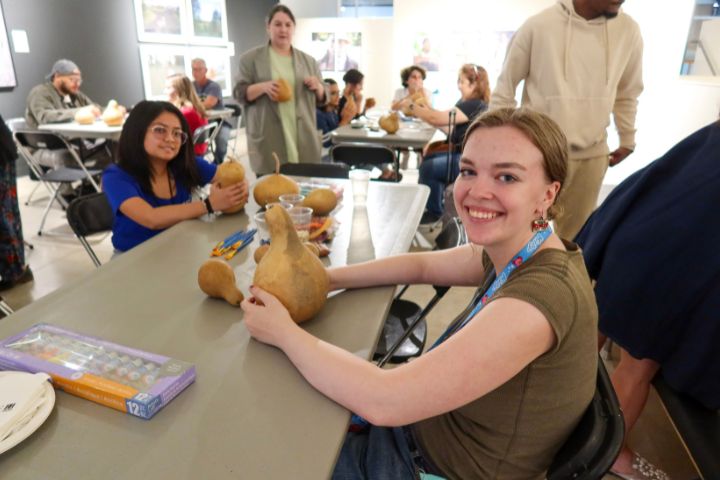
Indigenous Peoples' Day 2024
Stockton marked its fourth year celebrating Indigenous Peoples' Day, a counter-holiday that centers on the history, culture and continued experiences of the Indigenous people who stewarded this land before it became recognized as the United States of America.
The Oct. 14 celebration began with a recognition of place and poem by Tyrese "Bright Flower" Gould Jacinto of the Nanticoke/Lenni-Lenape Tribal Nation and welcome remarks by Stockton President Joe Bertolino.
Later in the day, two panel discussions were held — one in the Campus Center Theatre following a screening of a documentary written and produced by Associate Professor of Communication Studies Jeremy Newman and one in the Art Gallery centered on Indigenous life and culture.
"The objective of this exhibition and corresponding events is to represent the artists who are actively engaged in shaping the contemporary USA cultural landscape. 'Indigenous Approaches, Sustainable Futures' and related programming affirm Stockton's commitment to honor and work with Indigenous communities."Mariana Smith
The 30-minute excerpt of the documentary delved into the complicated role of the Christian church, the tribe's fight for sovereignty and official recognition and the passing of the torch to the next generation of tribal youth.
Ashton Pempanik Dunkley, a doctoral candidate from "the most southern of tidewaters," shared that being raised by a mother who is an artist had a profound impact on how she viewed art, saying that the act of creation grounds her, especially when her identity as an Indigenous woman is questioned.
When Newman, who served as the panel's moderator, asked the panelists to discuss the relationship between art, culture and identity, all of them referred to their personal experiences with their tribe and family.
Gould Jacinto and Ty "Dancing Wolf" Ellis, founder and CEO of LRP, expressed that art isn't always physical but something experienced while creating memories with loved ones in the community.
"Art, to me, is a group of people cooking, making chow-chow or corn soup. Art is, at a gathering, making pine-needle baskets together, telling stories for elders, youth and everyone else in between," Gould Jacinto said. "Art is that cohesive community tie that we take for granted. Art is not just about the end-piece but spreading traditions for the next generations to learn. Art is the community."
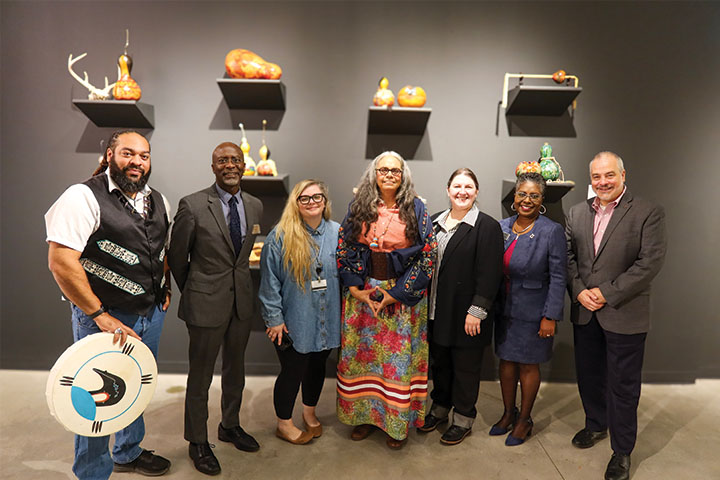
"One of the artists in our community has his own barbershop in Philly, and he's like, 'This isn't art,' but it very much is an art – you do what you do, and people come back for you for a specific reason: because you do art with what you do," Ellis said. "Like (Tyrese) was saying, us getting together, the energies that we create and the memories that we make are art."
Local Tribal Communities Celebrated
An exhibit held at the Noyes Arts Garage of Stockton University celebrated two southern New Jersey tribal communities by displaying historical documents, traditional artifacts and contemporary art.
“Still Here: The Nanticoke Lenni-Lenape and Powhatan-Renape Nations of Southern New Jersey” opened in October 2024 and ran through Jan. 5, 2025, bringing attention to two area Indigenous communities that share a common culture, languages, historical roots and a united commitment to preserving their past, present and future, said the exhibit’s curator Phoebe Farris.
“The first two words in the title of this exhibition are used in many Native-themed exhibitions. I am not the first or last curator to include this popular phrase,” said Farris, a professor emerita at Purdue University in Indiana. She identifies as Powhatan-Pamunkey descent, and her research expertise centers on contemporary Indigenous art and culture.
“The phrase is used frequently because too many people in the United States and around the world think Indigenous peoples are extinct or just ‘remnants’ of past ethnic, racial and cultural populations that have become so mixed and ‘unpure’ that terms like Indigenous, Native American, American Indian and First Nations do not really apply to them. This current exhibition highlights that we are still here in New Jersey.”
Among the items in the exhibit were painted drums, baskets, beaded moccasins, jewelry, clothing, contemporary paintings, photographs, and feather headdresses. The exhibit also featured books, newspapers and other print media written by Indigenous scholars.
Indigenous History is American History
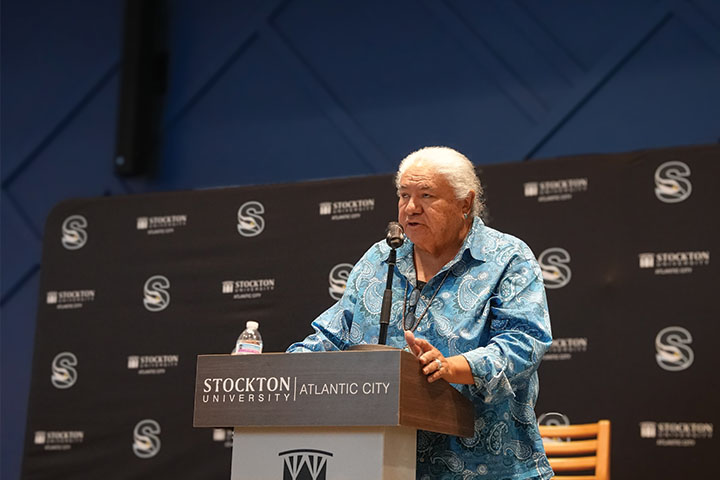
Stockton University got a head start on the preparations for the United States’ 250th anniversary as it hosted its Second Annual Arts and Culture Summit on Friday, April 4.
More than 140 people from about 40 different New Jersey organizations, artists, students and educators arrived at the university’s Atlantic City campus for a day-long event that featured breakout sessions on funding support for art and artists; art, culture and citizenship; art and our natural resources; technology and artistic expression; and art and community engagement. The 250th anniversary of the proclamation of the Declaration of Independence in Philadelphia is on July 4, 2026.
The summit’s keynote speaker was Indigenous artist Edgar Heap of Birds, who has had his work exhibited at some of the most renowned institutions in the world, including the Museum of Modern Art in New York; the Site Santa Fe Museum in New Mexico; and the Grand Palais in Paris. His art is also in the collections of many museums, including the Smithsonian Institution in Washington, D.C., and the Whitney Museum of American Art in New York City. Some of his work was on display in the Fannie Lou Hamer Event Room during the summit.
“Bringing together such a wide range of speakers and panelists from various disciplines and backgrounds not only enriches our conversations but also strengthens the connections between artists, organizations and community leaders,” said Michael Cagno, the executive director of the Noyes Museum of Stockton University.
Learn more about programming in the Art Gallery

